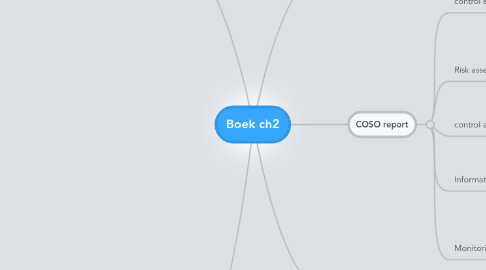
1. Cornerstone of internal control
1.1. steering paradigm
1.1.1. the controlled system (organization)
1.1.2. the control system (management)
1.1.3. the information system (the information received)
1.1.4. The environment
1.2. management cycle (People need to be managed to move them in the desired direction.)
1.2.1. planning
1.2.2. structuring
1.2.3. execution
1.2.4. evaluation
1.2.5. adjustment
1.3. information
1.3.1. An information system processes data to produce information.
1.4. Value cycle
1.4.1. segregation of duties
1.4.1.1. authorization
1.4.1.1.1. making decisions
1.4.1.2. Custody
1.4.1.2.1. safeguarding goods, money
1.4.1.3. Recording
1.4.1.3.1. recording sales, revenues in data collections
1.4.1.4. Checking
1.4.1.4.1. checks realization of plans
1.4.1.5. Execution
1.4.1.5.1. executes task by authorization
1.4.2. Reconciliation
1.4.2.1. relationship between offers and yields
1.4.2.1.1. to produce a certain product a particular quantity of raw materials, man hours and machine hours is required.
1.4.2.2. relationship between positions and events
1.4.2.2.1. there is a relationship between the opening balance of a inventory and the ending balance
2. Classifications of internal control
2.1. Direct check
2.1.1. assigned to processes, procedures
2.2. indirect check
2.2.1. applied to outcomes of processes and procedures
2.3. formal check
2.3.1. correspondence between procedures and recording of information
2.4. material check
2.4.1. examining the correspondence between the inventory as recorded in the general ledger and the inventory present in the warehouse
2.5. negative check
2.5.1. establishes the completeness of a recording
2.6. positive check
2.6.1. establishes the validity of a record
2.7. policy control
2.7.1. Evaluates the quality of decisions regarding the long-term strategy
2.8. standards control
2.8.1. comparing with standards and norms
2.9. expectations control
2.9.1. the realism of expectations and prognoses that underlie policies.
2.10. authority control
2.10.1. prevent unauthorized officers from gaining access
2.11. progress control
2.11.1. Continuity of operational processes
2.12. efficiency control
2.12.1. evaluates the operation in terms of cost control and realization of objectives
2.13. execution control
2.13.1. verify whether delegated tasks are performed in accordance with the related task assignments.
2.14. custody control
2.14.1. prevent unauthorized physical access
2.15. programmed controls
2.15.1. edit check, forcing users to fill in everything
2.16. integrity controls
2.16.1. regarding information systems
3. importance of internal control
3.1. For a number of years the top management of Robert Maxwell’s Mirror group withdrew large sums of monet from two organizations and the company pension fund to save the organization.
3.2. On the so called Walrus project of the dutch Ministry of Defense , involving two sophisticated submarines, large budget overruns went unnoticed by the management of the dutch royal navy and the ministry of defense.
4. COSO report
4.1. control environemnt
4.1.1. culture with respect to the importance of internal control
4.1.1.1. integrity and ethical values
4.1.1.2. interpretation of the tasks o/t board of directors
4.2. Risk assessment
4.2.1. establishing such measures that the residual risk is reduced to an acceptable level
4.2.1.1. Problems can be avoided
4.2.1.2. problems cannot be avoided:
4.2.1.2.1. implementing internal control
4.2.1.2.2. do nothing
4.3. control activities
4.3.1. preventive and detective control measures
4.4. Information and communication
4.4.1. recording transactions
4.4.2. matching internal documents
4.4.3. communication of procedures
4.5. Monitoring
4.5.1. ongoing activities
4.5.2. seperate evaluations
5. Corporate governance
5.1. deals with
5.1.1. control
5.1.2. decision making
5.1.3. responsibility
5.1.4. oversight
5.1.5. integrity
5.1.6. accountability
